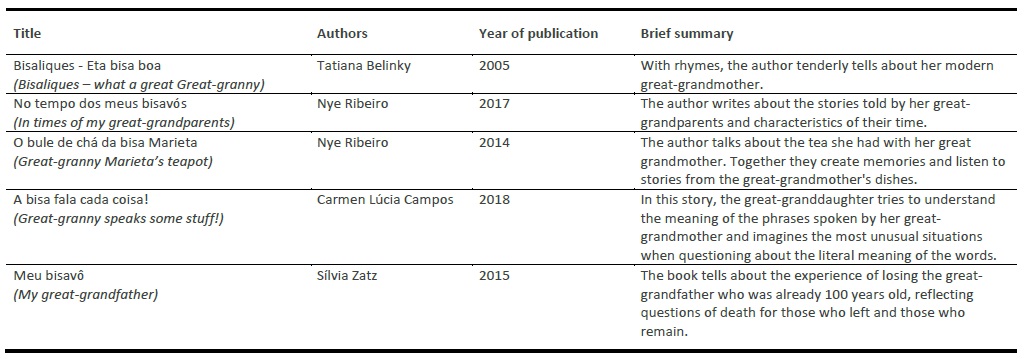Introduction
In contemporary times, there are profound sociodemographic changes that show the increasing number of elder people and life expectancy. It is noted that the current society differs substantially from the one of the past, in which there were a large number of children and young people and a smaller percentage of elders. Currently, the increase in aging is already a phenomenon observed worldwide, and it is possible to say that the world is aging. Thus, from the past to the present there has been a substantial change in the dimension and essence of old age.
According to the United Nations (2018), there are around 700 million people in the world over the age of 60 and it is expected to reach 2 billion by 2050. Brazil also follows this global trend of population aging, reaching to surpass the mark of 30 million elder people in the country (IBGE, 2017). According to the Brazilian Institute of Geography and Statistics (IBGE, 2017), the elder population has increased by 18% in the last five years, becoming more and more a representative age group in Brazil.
These sociodemographic changes and phenomena directly influence the family institution and enabled the occurrence of multigenerational families, that is, with four or even five generations, mainly due to the fact that women become long-lived (Dias et al., 2018). The great-grandparents-great-grandchildren relationship begins to emerge as potentially important. The intergenerational ties involved in the role of great-grandparents have still been little studied, mainly due to their rarity in the past. While in the past the presence of great-grandparents was reduced to a black and white photo, nowadays there is the possibility of coexistence between great-grandparents and great-grandchildren. In this sense, this study on the figure of great-grandparents is justified due to its intergenerational importance, which is something to be built for Family Psychology, as it is a growing social reality, however, still subject of little research.
1. The role of great-grandparents
Despite being a matter of importance, intergenerational relations have only recently gained increasing relevance, setting challenges to communication and also to solidarity between the generations of the 21st century (Ramos, 2012). Walsh (2016) explains that the postmodern family, as a fluid, plural structure, with different standards, values and practices, can potentially suffer some type of insecurity. For this reason, intergenerational and multigenerational relations have gained importance for families, in search of greater cohesion, well-being and support throughout life.
Due to the verticalization of family structures, Silva (2019) states that individuals grow older with more vertical than horizontal connections in the family and spend more time playing intergenerational roles than before. In this sense, intergenerational links accumulate with three levels of parent-child relationships, two sets of grandparent-grandchildren connections and one great-grandparent-great-grandchildren connection.
Regarding the role of great-grandparents, their intergenerational interlaces are observed, since they see the growth of three generations: children, grandchildren and great-grandchildren. According to the consulted literature, the first research focusing on the role of great-grandparents took place in 1985 in the United States of America by Wentowski. In the study, 19 great-grandparents with an average age of 82 years were interviewed, in regard to their perceptions about the role of great-grandparents, its meaning and their self-perception. From this research, Wentowski (1985) explains that three aspects in the role of great-grandparents are particularly important. First, the personal and family sense of renewal achieved by becoming great-grandparents, since this role reaffirms the continuation of the family. The satisfaction of seeing one’s family extend to the fourth generation generated strong psychological support in coping with old age. Second, great-grandchildren bring fun into their lives, as there are new tasks to do, new places to visit and new people involved. Wentowski (1985) highlights as a third aspect the longevity mark attributed through the role of great-grandparents. The author also pointed out that when comparing their behavior to their old role as grandparents, the participants felt that when they became great-grandparents, due to their advanced age and lack of geographical proximity, their ability to fulfill their great-grandparent role was restricted, contrary to what was acted out as a grandparent. They also felt more distant from the fourth generation. They pointed out that visits were the way they had to meet and accompany their great-grandchildren, giving them the opportunity to play and exchange affection with them.
It is important to highlight that through the activities performed by great-grandparents with their great-grandchildren, the older generation feels that they are going beyond their generation, even transcending their own time by transmitting family values and traditions (Andolfi, 2017). In addition, an important characteristic highlighted by Rabinovich, Azambuja and Moreira (2014), in their research with children from Bahia (Brazil) about how they see their great-grandparents, is the change for great-grandparents in the position from caregiver to those who are cared for. As with other family members, children, grandchildren and great-grandchildren move to the position of caregivers. In a sense, an inverted relationship is observed, since great-grandparents need help, and this relationship can manifest itself in a playful and positive way, if it is so mediated. The authors took the perspective of great-grandchildren and came to the conclusion that great-grandparents contribute in a rich way to the daily life of the family. Great-grandparents bring children closer to the notion of finitude, since they are even older than their grandparents. Children can experience a change in position from grandchildren to great-grandchildren and do not confuse the generational subsystems of grandparents and great-grandparents. Mahne, Klaus and Engstler (2018) raise the hypothesis that the relationship between great-grandparents and great-grandchildren, nowadays, becomes increasingly similar to what occurred between grandparents and grandchildren in the past, and that the one of grandparents and grandchildren approaches past relationships between parents and children.
According to more recent literature (Kniegge, 2016; Rabinovich, Azambuja, & Moreira 2014; Even-Zohar & Garby, 2016; Schuler & Dias 2019), great-grandparents assume a predominant place of emotional support for their great-grandchildren, involving activities such as telling stories and anecdotes, giving gifts, taking care of great-grandchildren, strolling with them, doing leisure activities, guiding and praying for them, among others.
Andolfi (2017) explains that greater coexistence over time between generations will have an influence on everyone involved. This interaction can provide the creation of an environment that provides the development of affections and creativity for all generations involved. For Ramos (2012), intergenerationality promotes education, respect and solidarity between generations. The intergenerational relationship is beneficial for all family members, making it a two-way path. While the affection of the youngest contributes to the renewed interest in life, pride, satisfaction and sense of usefulness of the elders, they transmit their experiences and can be a source of support and confidence. The author also explains that generations have the ability to protect, educate, stimulate, support each other, as well as interact when needed.
Despite advances in research on intergenerational relations, publications on the subject are still scarce (Azambuja, Rabinovich & Moreira, 2014; Dias & Schuler, 2019), which justifies the present study. Therefore, the general objective of this research was to understand the role of great-grandparents in the relationship with their great-grandchildren. More specifically, we sought to: identify the activities performed by great-grandparents with their great-grandchildren; understand intergenerational relationships between great-grandparents and great-grandchildren; and analyze the meaning of being and having great-grandparents.
2. Methods
Due to the proposed objectives, it was opted for a qualitative research as it allows to better understand the phenomena and relationships, prioritizing the object of investigation from what is put by the participants and the meaning they have for them. This type of approach allows a dynamic interaction between the real world and the subject, as an inseparable bond. A triangulation of data was carried out, since data collected in the interview of great-grandparents, in that of great-grandchildren and children’s books about great-grandparents will be placed in relation.
2.1 Participants
As for the criteria for choosing the participants, a convenience sampling was used. The participants in this research were five great-grandparents, as well as their great-grandchildren, totaling 10 people. Great-grandparents are of both sexes aged 60 and over. According to the Brazilian Law 10.741, following the United Nations (UN) referential, for a person to be considered elderly, in developing countries, the age of 60 years was established.
Marital status, education, or socioeconomic level were not considered for the choice of participants. However, they should enjoy a state of health that allows them to participate in the research. It was also decided to define a minimum age of seven years for the participation of the younger generation, that is, the great-grandchildren, to understand the instrument to be used, since they are already in school at this age.
The collaborators of this research were five great-grandparents (four great-grandmothers and one great-grandfather), aged between 74 and 97 years old; five great-grandchildren (one great-granddaughter and four great-grandsons), between 7 and 10 years old. The participants were identified with fictitious names, and the names with the same initial are great-grandparents and great-grandchildren from the same family.
2.2 Data collection instruments
A semi-structured interview with two scripts was used, one for the great-grandparents and the other for the great-grandchildren, covering topics such as activities performed together, characteristics of the relationship, as well as the meanings of being great-grandparents; in addition to a questionnaire with the participants' sociodemographic data.
To illustrate the theme, five children's books were also read and analyzed that deal with the figure of great-grandparents, who were found in virtual tallow of books. The titles were obtained by searching the virtual tallow homepage for the word “great-grandparents” and filtering the children's literature. The year of publication of these works ranged from 2005 to 2018, with all five books written in Portuguese and published in Brazil. Rabinovich and Azambuja (2017) explain that children's story books present textual material that brings content regarding how certain figures are seen, in addition to representations of phenomena, such as, for example, old age. Next, children's books used in this study will be presented in a table containing: title, authors, year of publication and a brief summary.
2.3 Data collection and analysis
After obtaining the approval of the Research Ethics Committee, under the CAAEE No. 60725816.4.000 5206, data collection started. Participants were nominated by people known to the researchers and are residents of the Metropolitan Region of Recife. Obtaining the approval of the participants, they signed the “Free and Informed Consent Form”. For underage participants, those responsible signed the consent form. The interviews were recorded and, later, transcribed literally, trying to maintain the maximum fidelity about what was said.
As for the children's books, these were searched on the Internet in virtual tallows using the keyword “great-grandparents”, following the criterion that they were written in Portuguese and published in Brazilian territory. It was decided to limit the search for children's books from the last 15 years so that there is no disparity regarding the time that the research participants are living in. The textual content was taken into account, as well as the illustration of the great-grandparents' character.
The data collected, whether through interviews or textual material from children's books, were analyzed according to the Thematic Content Analysis technique (Minayo, 2019a). The illustrations of the great-grandparents' characters were analyzed graphically in order to provide greater contextualization of the material in the children's books.
3.Analysis and discussion of results
The analysis and discussion of the results were built from data from interviews with great-grandparents and their respective great-grandchildren, as well as textual and graphic material from children's books, three thematic axes were formed, that are discussed below.
“My great-grandfather is very old”: The first thematic axe raised concerns about the advanced age of great-grandparents. It is interesting to note how great-grandchildren differentiate the age group between great-grandparents and grandparents, with great-grandparents being described as “very old” as seen in the following statements:
“He is very old, but he is really nice with me.” (Great-grandson Beto)
“My great- granny has already lived a lot... she has a lot of experience... but she is very old. She has some trouble walking, so we talk more.” (Great-grandson Daniel)
It is noteworthy that the activities will differ due to age, as can be read in the testimony of Daniel who thinks it is better to talk to his great-grandmother due to her difficulty in walking. The great-grandson Carlos also says: "my great-granny does not know how to play on the cell phone, but my grandma does", also differentiating the activities according to the age group. This age distinction is also noted in the studies by Rabinovich, Azambuja and Moreira (2014), explaining that great-grandchildren do not confuse the grandparents and great-grandparents subsystems. In addition, the authors point out that living with great-grandparents allows a greater sense of time for great-grandchildren, which corroborates the results presented.
Resembling the description of great-grandparents given by the great-grandchildren in the present study, children's books also bring illustrations that demonstrate the advanced age of the grandparents, for example, the use of glasses, as shown in the following figure 1.
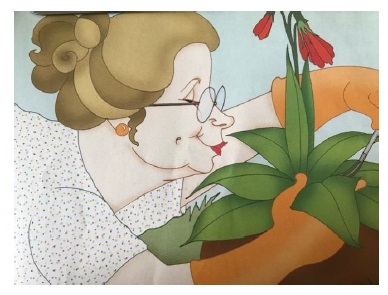
Font: Belinky, T. (2005). Bisaliques: eta bisa boa!. São Paulo: Paulus.
Figure 1 Graphic characterization of great-grandmother.
It is observed that in the speeches of great-grandparents the question of old age is also mentioned both in the sense of having physical limitations, as the great-grandfather Bartolomeu points out: “Age no longer allows me to do what I would like, I am already 95 years old”; as well as from a positive perspective as we read in the statement below:
“When I say that I am a great-grandmother, some people say that I am already very old, that old age has arrived. I answer: yes, old age has arrived and I will enjoy it, this is now the new phase of my life! I just enjoyed my childhood, then so many things came, and I didn't live any of those phases of life after this one ... now I'm going to live!” (Great-grandmother Carmem).
These statements make it clear that the notion of old age has changed both in terms of how it is seen and lived (Minayo, 2019b). In the five children's books that were analyzed, old age stands out as an active life phase, as Belinky says (2015, p.12): “Life for great-granny is a landscape to be enjoyed 'on the go' - it is not grimace, she walks on a bicycle and doesn't mind gossip”. The fact that children's books bring stories starring great-grandparents, in which they actively participate in the lives of great-grandchildren through conversations in order to provide support and pass on their lived stories, brings new connotations to the old age phase.
“Great-granny tells stories of her life”: Due to the advanced age of the grandparents, the literature indicates that the number of tasks that they can perform would be more limited (Dias et al, 2018) However, their support stands at an emotional level, as shown by Rabinovich, Azambuja and Moreira (2014), thus being in form of conversations, advice and prayers. Children's books contain stories that demonstrate activities such as conversations, snacks and telling stores that were experienced by great-grandparents. As seen in the following illustration, the book shows a scene in which a great-grandmother and great-granddaughter are sitting drinking tea and talking.
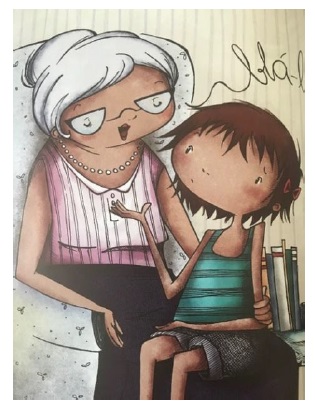
Font: Campos, C.L. (2018). A bisa fala cada coisa. São Paulo: Panda Books.
Figure 2 Graphic characterization of the great-grandmother.
In the book “In the time of my great-grandparents”, the story is about how great-grandparents lived in their time, bringing illustrations from this time, inducing the reader to imagine that great-grandparents were telling stories that they lived in the past. In the following illustration, the narrator explains: “Some houses had a phonograph, or hand-cranked gramophone. And there was no stereo, no CD, no DVD, no mp3” (Ribeiro, 2014, p.5). It is interesting that the great-granddaughter includes herself in the scene of the great-grandparents dancing, imagining herself at the time.
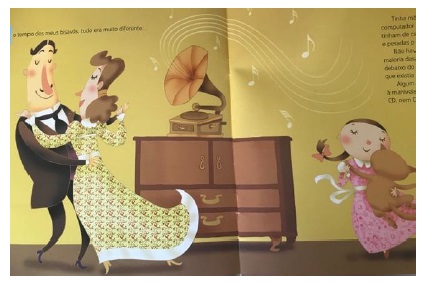
Font: Ribeiro, N (2017). No tempo dos meus bisavós. São Paulo: Editora do Brasil.
Figure 3 Graphic characterization of great-grandparents and great-granddaughter dancing.
These results corroborate with the findings of the present study, in which the tasks mentioned were: talking, caring, supporting, advising, praying, having lunch together, watching television programs with great-grandchildren, playing, making toys for great-grandchildren, watching them dance and sing, walk and cook their favorite foods. It should be noted that, despite the physical limitations that may be present in great-grandparents, there are several activities that they can perform with their great-grandchildren and with the family in general. The results obtained showed that great-grandchildren demonstrated their pleasure in sharing experiences with their great-grandparents, highlighting activities done together as: taking pictures with the great-grandmother, having lunch together, going to family events, playing on the great-grandparents' sidewalk, being seen playing by the great-grandparents, inventing toys and games, talking, watching movies, listening to stories from the life of great-grandparents, according to the following statements:
“I like to play with my great-grandparents, watch my movies with them, go out with them by car, many things like that. We talk, play, walk, run, make up games ... It's very good” (Great-grandson Eduardo)
“I like to talk to her and listen to the stories she likes to tell, they are not book stories, they are stories she went through in life. I love to listen ... we spend a lot of time together and she telling us these stories” (Great-grandson Daniel)
It is interesting to note how the great-grandmother appreciates the possibility of having time to be with these great-grandchildren, emphasizing that she does this without haste, as it is possible to read in the statements:
“Today, with my great-grandchildren, I do more things because I have more time, play, talk, watch the programs with them on television, I like to hear them sing and dance too, all of this in no hurry, because now I have a lot of time to do that. I'm so happy with them” (Great-grandmother Carmem).
“With so many children, I had to hurry and I didn't have time to play, to talk ... the daily struggle was huge (...) now with my great-grandchildren I have more time to talk, exchange ideas, with tranquility. I like to hear them talk about the news” (Great-grandmother Daniele).
Sometimes as grandmother, it was not possible to have this space, since the grandmother eventually assumes multiple roles, as often the child's parents work outside the home, thus corroborating with Mahne, Klaus and Engels (2018) that punctuate how the role of today's great-grandmother resembles that of the grandmother of the past.
Children's books present an image of great-grandparents who tell stories, make snacks and talk, corroborating what we saw in the data obtained through the interviews. The connection with the past of the great-grandparents is emphasized more than their insertion in the present time. Even so, it is interesting to note that, as in the speech of the interviewed great-grandchildren, the textual material in children's books brings a vision of the great-grandparents' old age as something special, as we read in Belinky's book (2005, p.12): “Great-granny fear doesn’t have, it’s the truth, from that “old age”. Enjoy all the grandchildren, play with the great-grandchildren - she knows what happiness is ”. The great-granny's snacks with the great-granddaughter are also treated in Ribeiro's book (2014, p.4): “But the tea that the great-granny serves in this teapot, you don't believe it! Melissa, chamomile, lemongrass, fennel, mint, apple tea with cinnamon, ginger tea ... Everything so warm that it warms your heart”. In this research, it can also be seen that the great-grandchildren highlighted the meals together, as in the following statement: “He always does something that I like for lunch. This is really cool, because I have lunch with him every Thursday”(Great-grandson Beto).
In the interaction between great-grandparents and great-grandchildren there is also the occurrence of generational shocks that can lead to possible conflicts to be overcome and resignified. In Campos' children's book (2016, p.9), this generational shock is demonstrated through the language of the great-grandmother who brings slang from the past and the great-granddaughter wonders about the literal meaning of the phrases used, such as: “She always complains about pain in the leg potato. Is it so much to eat french fries?”. The customs of great-grandparents' times can sometimes seem a little difficult to imagine for great-grandchildren, who were born in the internet age. Ribeiro's book (2013, p.6) deals with this theme by presenting these time differentials: “My great-grandfather told me that when he was a little boy, he found it very fun to take pictures. The photographer covered his head with a dark cloth and said ‘look at the bird’ ”.
In the speeches of the great-grandchildren, in the following, show how sometimes coexistence between two generations of different ages can be difficult:
“Sometimes it's really fun, but sometimes it's kind of boring, because I don't have much to do” (Great-grandson Beto).
“At the great-granny’s house I have to be quieter ... but I like it” (Great-granddaughter Amanda).
The challenge is to find activities that appeal to both generations, despite the difference in time and age, as great-grandson Carlos explains: “She speaks softly and likes to listen to music ... I like it too”.
“Great-granny is a blessing”: The meaning of being and having great-grandparents is crossed by positive affections, such as: love, remembrance, affection, learning and blessing. As we see in the following lines:
“With great-granny I learned love and that I can't be mad all the time” (Great-granddaughter Amanda).
“Love, they are very affectionate with me, I feel very happy for that” (Great-grandson Eduardo).
“I watch the church program on television a lot with great-granny, which is why I say my great-grandmother is a blessing” (Great-grandson Daniel).
Great-grandparents bring meaning with the resumption of a story or a new chance to see children grow up within the family, in addition to being a possibility to leave memories and pass on a family legacy. As Rabinovich, Azambuja and Moreira (2014) point out, being great-grandparents is directly linked to the legacies that can be passed on to the next generations as a way of life continuity. Daniele highlights: “It is the new beginning of a story where you teach, educate and, above all, love”. Bartolomeu says: “For me being a great-grandfather it is a world of reminiscences ... It brings a world of memories, when I was a father, then my children grew up and I was a grandfather and today my children are grandparents and I am a great-grandfather. I didn't think I would live those moments. And also, who knows, right? Maybe I can leave some memories for these boys”.
Children's books corroborate with this issue of leaving an inheritance by highlighting the stories of great-grandparents, but they also bring these special aspects of affection, love and learning as we read in the following excerpt: “I love it when the great-granny says that I am the apple of her eye. Then I don't even need an explanation. It's love and that's it! ”(Campos, 2016, p.31). The illustrations also bring this dimension of affection, going beyond the textual.
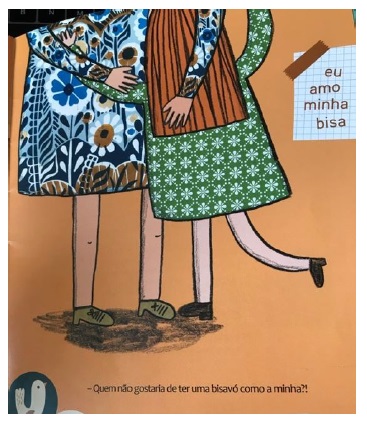
Font: Ribeiro, N (2014). O bule de chá da Bisa Marieta. São Paulo: Editora Roda Viva.
Figure 4 Graphic characterization of great-grandmother hugging her great-granddaughter.
Final considerations
It can be confirmed in this research, corroborating with the consulted literature, that the role of great-grandparents is involved by multiple intergenerational relationships. In the relationship between great-grandparents and great-grandchildren, the cases presented demonstrate possibilities for learning, mutual support, respect and intergenerational solidarity, but also conflicts and tensions because they are generations that live and lived in different social times. It is interesting to note that the relationship is permeated by the stories lived by great-grandparents who serve as experience and subject for both conversations, as well as for advice and emotional support. The role of great-grandparents in this relationship appears to be mainly emotional support for great-grandchildren, in addition to being agents of transmitting family and cultural legacies.
The activities carried out by great-grandparents in this relationship translate into advice, guidance, prayers and affection, which are expressed in different ways, depending on the generation in question, such as, for example, a lot of conversation with great-grandchildren, a lot of playing. The exercise of these activities and others are the means of connecting with the other generations. It was important to note that great-grandchildren seem to appreciate this contact with great-grandparents, despite the great age gap.
It is noteworthy that the methodology using semi-directed interviews with the generations of great-grandparents and great-grandchildren brought intergenerational nuances. The triangulation with children's books broadened the view of the intergenerational relationship, bringing both the stories told and the stories lived by great-grandparents and great-grandchildren. Children's books direct the stories to aspects of great-grandparents' legacies, but also show the interaction of the two generations filled with great affection.
It is believed that the limitations of the research refer to the fact that the great-grandparents and great-grandchildren who were heard are inserted in the Northeastern reality of Brazil, therefore, it would be indicated to carry out research with these characters both in other regions of the country, as in other countries. Another suggestion for future research would be to take into account inclusion criteria for participants that take into account the socioeconomic and educational levels. It is also pointed out the little participation of great-grandparents, which in this research was restricted to one.
However, it should be noted that this topic has not been exhausted. The scarcity of literature in Brazil reflects the need for research on the generation of great-grandparents. As Belinky concludes (2015, p.15): “Speaking tenderly in a certain modern way, grandmothers and grandfathers and any other old people deserve to be loved, cherished and respected”.














